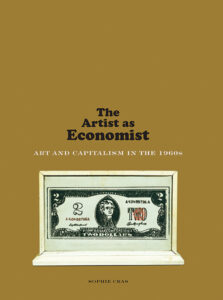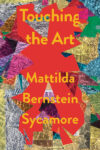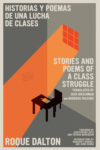
[Yale University Press; 2019]
Tr. from the French by Malcolm DeBevoise
Only Marxism can give us an adequate account of the essential mystery of the cultural past . . .
—Fredric Jameson, The Political Unconscious
Sophie Cras’s The Artist as Economist: Art and Capitalism in the 1960s, opens upon a discussion of Robert Filliou, a French Fluxus artist with formal training as an economist. Filliou bookends this text, marking the prime through line of its investigation. Cras claims that Filliou “[sought] to go beyond class divisions and political dogmas” and sought to discover “a third way between the two dominant systems [of capitalism and socialism].” While Cras states that Filliou’s interest in art as a potentially “generative source of a more meaningful way of thinking about economic life itself” is “emblematic” of the “artists in the capitalist world of the 1960s [who] put the economic life of their time to the test of artistic creativity,” it also marks the modus operandi of Cras’s methodological intervention. This monograph itself relies upon an attempt to develop a third way of art criticism, one which can escape the “privileged status accorded by scholars in the humanities and social sciences to the critique of the consumer society, on the one hand, and to the Marxist analysis of labor and value, on the other.” This methodological third way, lacking the willingness to construct anything like a thoroughgoing critique of either the content of these aesthetic forms or the effects of the global restructuring of capital during 1960s, ends up merely an exposition of how currency crises and financialization find themselves deeply integrated into differentiated (and combined) aesthetic forms which move within transatlantic circuits between America and Europe, mutating and shifting meaning in their travel as they engage with the particular histories of their respective national economic sphere. Even as this text overtly laments the degree to which Marxist art criticism has focused too greatly upon the political underpinnings of the artwork (ideology critique), this study ultimately finds itself succumbing to its own third way politics, transmogrifying a period of crisis, upheaval, and conflict into one in which the predisposition of artists within the period to integrate inquiries of “value, currency, financial markets, and commerce” into their work resulted in muted reflections of capitalism’s inevitable hold on the spectacles of the artworld.
The text itself, divided into four chapters featuring a plethora of beautifully laid out reproductions of the works being analyzed, assembles a rather fascinating archive and does succeed in illuminating an intellectually rigorous and intriguing set of connections between geographically distant and formally distinct artistic practices. The first chapter turns to Yves Klein (which leads into a brief detour through Edward Kienholz) and Giuseppe Gallizio in order to see the ways in which both of these artists attempted to assemble alternative theories of value, the former crafting a model rooted in the intrinsic values discoverable in scarcity and the latter advocating on behalf of a practice rooted in industrialized plentitude. While Klein sought to construct a kind of barter economy which would eliminate the need for a monetary intermediary subject to shifting valuations, Gallizio undertook an experiment in industrial painting that proclaimed to sell painting by the meter in the hopes of undercutting the lure of the singular, fetishized art object, making an accessible and mass produced form of luxury available to all. Both theories of value failed to find sustainable groundworks for their own reproduction and neither seemed to have had much to say about the labor theory of value whatsoever. The second chapter, turning to the currency paintings of Larry Rivers and Andy Warhol, argues that these artists “questioned the institutional, religious, and political values on which public confidence rests and the nature of the credit on which works of art and currency both depend.” This chapter performs a magnificent reading of both the histories of the specific currencies being depicted and the functions of currency’s underlying nature as a form of representation bound together in a social confidence of its mimetic soundness. However, Cras never quite arrives at an argument for how the “exposing [of] monetary conventions for what they are” creates an opening into the possible remaking and alternative performance of these very relations, instead opting to suggest that these artists satirized an illusion (albeit a social relation that is hardly so illusory for those excluded from participation within this ritual of exchange through their own lack of cash). The third chapter attends to the engagement between conceptual artists (here represented by Bernar Venet, Dennis Oppenheim, Dan Graham, Les Levine, Lee Lozano, and Robert Morris) and the stock exchange. This chapter sees the work of Venet and Oppenheim as “spectacularizing speculation, of transforming financial activity into an entertainment” and looking to how the “exercises in ‘artistic shareholding’” practiced by Graham, Levine, Lozano, and Morris could place “the artist [as] an actor in the spectacle of speculation, not merely a spectator.” The last chapter turns its attentions to the circuits of commercial circulation as reimagined by Ray Johnson and Marcel Broodthaers. The strongest section of The Artist as Economist is certainly Cras’s reading of the makeshift gift economy of Ray Johnson’s mail art, characterizing Johnson’s practice as “restoring the social dimension of trade while at the same time warning against the threat commerce poses of converting human beings into commodities.” In Cras’s rendering of Johnson, we find an artist desperate to control the commercial trade routes of his own work by crafting his own regulatory system of its reception, a kind of planned economy on a microcosmic scale.
In the conclusion of this text, Cras once again returns to the Fourierist Filliou, thinking through his unfinished treatise, Principles of Poetical Economy, and once again claiming that this monograph is meant to operate as a kind of corrective on those recent works of art criticism written “from an anticapitalist perspective, often with frankly militant intent.” However, in a work attempting to strip any hint of political ideology from both critic and artist, Cras’s final words are most certainly political, even as they attempt to negate this very notion:
To be sure, none of [these artists] seriously challenged the economic orthodoxy of the period. Indeed, considering the resurgence of neoliberal capitalism in the decades since, it is tempting to say that artists during the 1960s not only failed to deflect its trajectory, but actually helped to hasten its ascendancy. To this one may nonetheless respond, with Filliou, that the impact of a work of art cannot be measured on such a limited scale. ‘My artistic propositions are advanced within the framework of a period of five billion years,’ he explained. ‘Over the long term, there can be no doubt that these prospects will be realized.’ It is up to all of us who look at art and the world today, and to all of those who will come after us, to imagine what poetical economy may one day be able to do for political economy.
This concluding assertion, a turning to the political that is ultimately a turn to the platitudinous reminders that ideology blinds us to the purity of an aesthetic work, suggests that only an observer stepping out of history can adequately judge the cultural productions of the past. Just as much as we can be certain that the artists discussed herein did nothing to seriously challenge the economic orthodoxy of the period, we can also be certain that without a substantive challenge to capitalism (that mode of production which has always been rooted in systemic cycles of accumulation of which financialization has always played a part), the timescale with which we may accurately be able to assess these works will be exponentially more compressed than the five billion years Filliou suggests we need. In fact, we know we have no time at all. We already kn(e/o)w what is to be done, then as well as now. The only viable third way between socialism and barbarism remains the multitudinous possibilities for our futurity which linger embedded within that demand of “full communism now,” a demand deeply embedded within the aesthetic imaginary of the period, locatable so long as we care to see that neither artist nor critic need be an economist in order to identify the violent machinations of capital. There is no other third way.
Clint Williamson is a PhD Candidate in English at the University of Pennsylvania.
This post may contain affiliate links.







